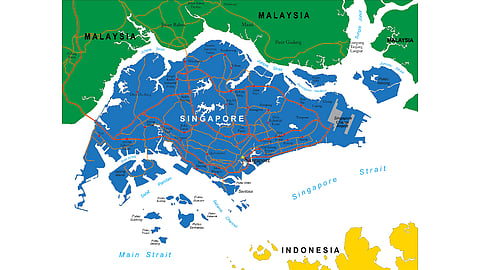

Singapore’s EMA says the country targets to increase its 2035 low-carbon electricity import goal by 2 GW
The agency has given Conditional Licenses to 5 low-carbon electricity projects located in Indonesia
It has also advanced 2 more low-carbon energy projects with 1.4 GW capacity to supply power to Singapore
Singapore plans to raise its ambition to source up to 4 GW of low-carbon electricity by 2035 via imports by 2 GW to 6 GW in order to meet its future energy needs, going by the country’s growing demand, according to the Energy Market Authority (EMA).
In 2021, the country’s Deputy Prime Minister and Minister for Trade and Industry Gan Kim Yong announced the country’s plans to import up to 4 GW of low-carbon electricity. Since then, the EMA says it has received more than 20 proposals from multiple source countries. Keppel Energy’s 1 GW project in Cambodia is one such project (see Singapore To Import Low-Carbon Electricity From Cambodia).
It said that this demonstrates the viability of low-carbon electricity imports as a pathway for decarbonizing the power sector.
Of these 20, the EMA has issued Conditional Approvals for 9 projects so far. Now it has awarded Conditional Licences to 5 of these projects that represent a combined 2 GW capacity that will be imported from Indonesia.
These 600 MW, 400 MW, 400 MW, 300 MW, and 300 MW projects are helmed by Pacific Medco Solar Energy, Adaro Solar International, EDP Renewables APAC, Vanda RE Pte Ltd, and Keppel Energy Pte Ltd, respectively. All of these projects secured Conditional Approvals in September 2023 (see Singapore 1 GW Short Of 4 GW Low-Carbon Goal).
Once these projects fulfill the obligations in the Conditional Licenses, the EMA will advance them with an Electricity Imported License to pave the way for their construction and commercial operations. This 2 GW capacity is targeted to achieve commercial operations from 2028 onwards.
Additionally, the EMA has also granted Conditional Approvals to 2 more projects to import 1.4 GW of low-carbon electricity from Indonesia after finding them technically and commercially viable. Singa Renewables, a TotalEnergies and RGE joint venture (JV), has secured the approval for a 1 GW project, and Shell Eastern Trading and Vena Energy have been awarded one for a 400 MW facility.
The EMA plans to continue to explore more credible and commercially viable proposals to contribute to the country’s 2050 net-zero ambitions. It will also study all other decarbonization pathways for the power sector, including hydrogen, solar, deep geothermal energy, nuclear energy, and carbon capture and storage technologies.
Singapore and Indonesia have agreed on an energy cooperation to facilitate cross-border trading projects and interconnections between the 2 nations. Multiple memoranda of understanding (MoU) signed between the duo also include investment in the development of renewable energy manufacturing industries such as solar PV and battery energy storage systems (BESS) in Indonesia.
The Australia-Asia Power Link (AAPowerLink) project is another low-carbon electricity project under which SunCable plans to supply solar power to Singapore via subsea cables to cover the country’s 15% electricity supply (see Environmental Clearance For World’s Largest Planned Solar & Storage Project).
